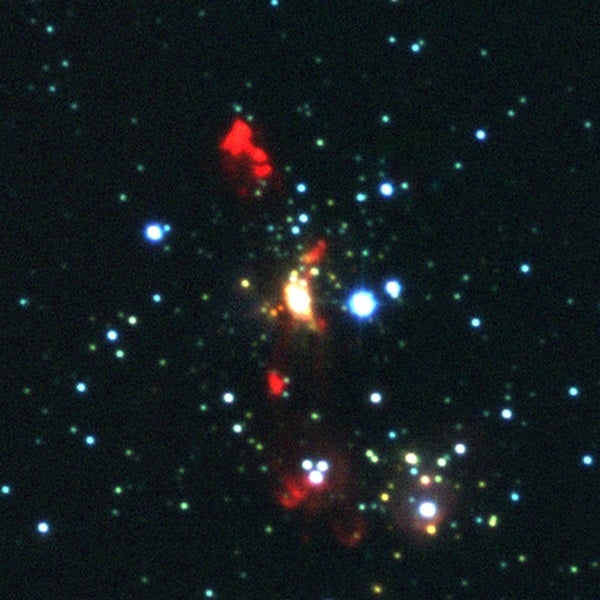Using the United Kingdom Infrared Telescope (UKIRT), astronomers have found the leading mechanism by which most of the massive stars form in our galaxy. The largest near-infrared survey of massive star-forming regions to date has revealed that a major fraction of these massive stars form by collecting matter onto disks around their equatorial regions. This was revealed by the detection of gas outflows and shocked regions associated with massive young stars in formation, located in clouds of gas and dust in our galaxy.
The survey was carried out by a team lead by Watson Varricatt from the Joint Astronomy Center in Hilo, Hawaii, and included Chris Davis, also from the Joint Astronomy Center, Suzanne Ramsay from the European Southern Observatory (ESO) in Germany, and Stephen Todd from the United Kingdom Astronomy Technology Center (UKATC) in Edinburgh, United Kingdom.
Scientists know that lower-mass stars like our Sun form by gravitational collapse of material inside clouds of gas and dust in space. The gas and dust spiral down onto the equatorial regions of the young star via a process known as accretion. At the same time, these accreting young stars drive high-velocity jets of gas outward at thousands of miles per hour. These “outflows” radiate at infrared wavelengths — this emission is actually produced by hydrogen molecules heated to thousands of degrees. Consequently, astronomers can use observations in the infrared to search for not only the youngest stars, but also evidence of the accretion process.
The big question is, do the massive stars form the same way, or do they form using a different process?
For massive stars with masses larger than 10 times the mass of our Sun, it has been proposed that the extreme energy output of these young stars, which start nuclear burning in their cores even before they complete their growth through accretion, will prevent further growth by blowing away the accretion disks. Hence, alternate scenarios like mergers of lower-mass stars have been suggested as the main mechanism for massive star formation. The presence or absence of outflows from massive young stars will tell us whether accretion or some other method leads to their formation.
“Most of the massive young stars in formation are confined to the galactic plane and are located in giant molecular clouds extending over several or even tens of light-years,” said Varricatt. “They are hidden behind large amounts of gas and dust, which hampers their detection at visible wavelengths. To understand the formation of massive stars, we need to observe them at wavelengths that allow us to peer through these layers of gas and dust. Obtaining sharp images of these often very distant objects is also crucially important. The high sensitivity of the UKIRT Fast-Track Imager (UFTI) and the infrared capabilities of UKIRT were well suited to these observations.”
The team performed a near-infrared imaging survey of 50 bright young stellar objects using UKIRT and UFTI. Observations were done in the narrow-band filter centered at 2.122 microns and in the broadband filter at 2.2 microns. The former is the wavelength of an emission line of molecular Hydrogen (H2), which is abundant in the molecular clouds where stars form.
“Seventy-six percent of the objects surveyed showed molecular line emission; most of these are due to outflows. Within our sample, the outflows are seen to be well-defined irrespective of the energy output of their central young stars and are nearly as well-defined as those from low-mass stars,” said Varricatt. “These outflows detected by us at infrared wavelengths agree with the outflows detected at longer wavelengths such as in the millimeter regime, and appear to be driven by jets like those from low-mass stars. We conclude that massive stars up to at least 30 times the mass of our Sun form through disk accretion.”
“A conclusive result required observations of a large number of massive young stars,” said Davis. “Credit is certainly due to the dedicated team of astronomers, technicians, and software engineers working at UKIRT. Without their help we would not have been able to observe so many stars on so many different nights.”
“This is a fantastic and long-awaited result,” said Davis. “This comprehensive survey addresses one of the key questions in modern astrophysics, which is the formation mechanism for high-mass stars. These observations took several years to complete, and they took advantage of UKIRT’s unique capabilities. Indeed, this result demonstrates that mature telescopes can still deliver ground-breaking science, and it is rewarding to see the observatory used in this way.”










